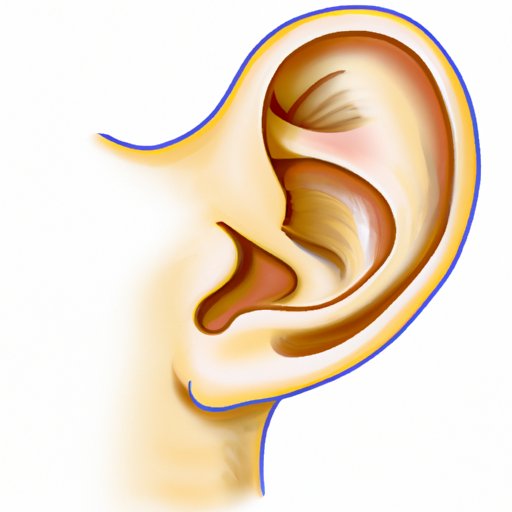Introduction
Hearing is a complex process involving the ears, brain, and nervous system. When sound waves enter the ear, they are converted into electrical signals that are sent to the brain for interpretation. It is important to understand how sound travels through the ear in order to appreciate the effects of hearing loss and its impact on communication. The purpose of this article is to explore how sound travels through the ear in detail.

Anatomy of the Ear and How Sound Travels Through it
The ear consists of three main parts: the outer ear, the middle ear, and the inner ear. The outer ear includes the visible part (the pinna) and the ear canal. The middle ear includes the eardrum and three tiny bones known as the ossicles. The inner ear contains the cochlea, which is responsible for converting sound waves into neural signals that can be interpreted by the brain.
When sound waves enter the ear canal, they cause the eardrum to vibrate. This vibration is then transferred to the ossicles, which amplify and filter the sound waves. The amplified sound waves then travel to the cochlea, where they are converted into electrical signals that are sent to the brain for interpretation.
Role of the Three Tiny Bones in Middle Ear
The three tiny bones in the middle ear – the malleus, incus, and stapes – play an important role in transmitting sound. These bones, known collectively as the ossicles, amplify and filter the sound waves before passing them on to the cochlea. The malleus is attached to the eardrum and receives vibrations from it. The incus acts as a bridge between the malleus and the stapes, which is the smallest bone in the human body and is connected directly to the cochlea.
The amplification and filtering process provided by the ossicles helps to ensure that only the most important sound waves reach the cochlea for interpretation. Without this amplification and filtering, sound would be much less clear and would not be interpreted correctly by the brain.

Amplification and Filtering of Sound Waves in the Cochlea
Once the sound waves have been amplified and filtered by the ossicles, they travel to the cochlea, which is filled with fluid. Inside the cochlea, the sound waves are further amplified and filtered. This process is known as “cochlear amplification” and helps to ensure that only the most important sound waves reach the brain for interpretation.
The cochlea also plays an important role in distinguishing between air and bone conduction. Air conduction is the transmission of sound waves through the air, while bone conduction is the transmission of sound waves through the bones of the skull. The cochlea is able to distinguish between air and bone conduction, allowing it to interpret sound more accurately.
Effects of Hearing Loss
Hearing loss can have a significant impact on how sound travels through the ear. People with hearing loss may experience difficulty understanding speech, difficulty localizing sound sources, and difficulty hearing certain frequencies. This is because their ability to detect sound and convert it into neural signals has been diminished.
It is also important to note that hearing loss does not just affect humans; it can also affect animals and other species. For example, some species of bats rely on echolocation to navigate and communicate. If these bats suffer from hearing loss, their ability to use echolocation will be significantly diminished.
Other species, such as whales and dolphins, also rely heavily on their sense of hearing to communicate and locate food. If these marine mammals suffer from hearing loss, their ability to find food and communicate with one another will be severely impacted.
Conclusion
In conclusion, this article has explored how sound travels through the ear in detail. We have discussed the anatomy of the ear, the role of the ossicles, and the process of amplification and filtering of sound waves in the cochlea. We have also examined the effects of hearing loss on sound transmission, and compared and contrasted how sound travels through the ear in humans, animals and other species.
It is clear that our ears are incredibly sophisticated organs, and understanding how sound travels through them is essential for appreciating the effects of hearing loss. If you would like to learn more about hearing loss and how sound travels through the ear, please consult your doctor or audiologist for further information.
(Note: Is this article not meeting your expectations? Do you have knowledge or insights to share? Unlock new opportunities and expand your reach by joining our authors team. Click Registration to join us and share your expertise with our readers.)
